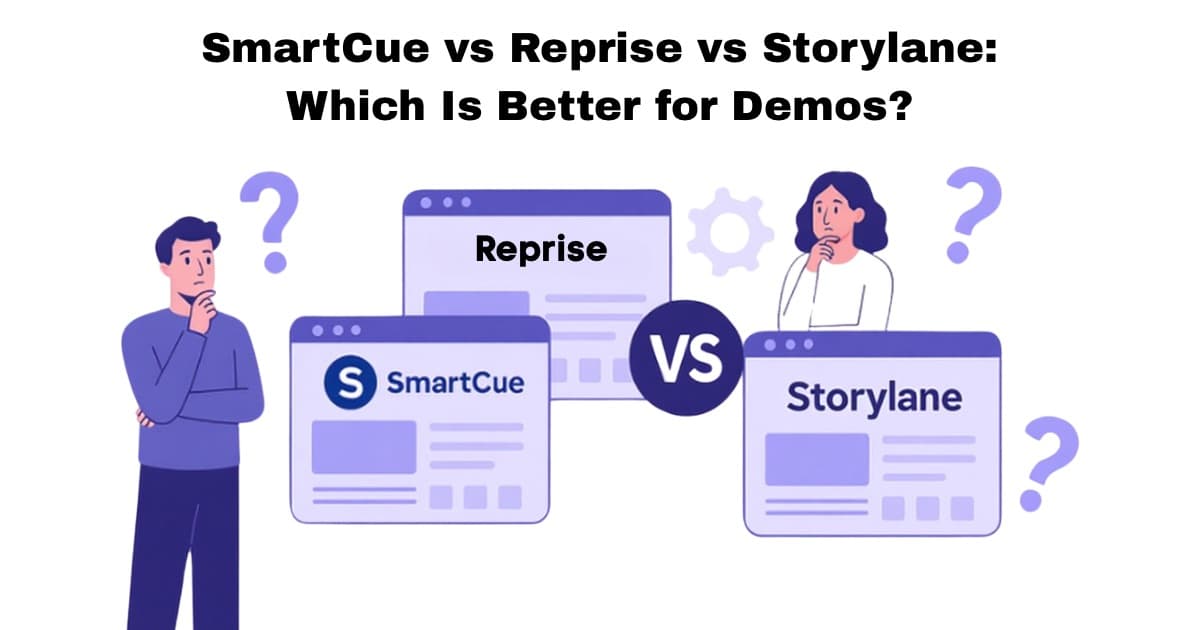
TL;DR
|
Ever been on a sales call where your demo crashes mid-pitch, just as the prospect leans in? We’ve all felt that sinking moment: frozen screens, panicked clicking, and a forced smile from the buyer saying, “It’s okay, take your time.” But in sales, time is the last thing you can afford to waste.
That’s why many teams turn to demo automation tools like Demostack. These platforms let you create interactive, no-risk versions of your product, so you can showcase features without touching your live environment. It sounds like the perfect fix… until you hit the wall of enterprise pricing, complex onboarding, and weeks of setup just to get one usable demo out the door.
That’s where SmartCue comes in: a lighter, faster, no-code alternative built for modern go-to-market teams. In this guide, we’ll break down five top Demostack alternatives for 2025; but if you’re looking for a tool that skips the friction and gets you demo-ready in minutes, SmartCue might just be your best bet.
What is Demostack?
Demostack is demo software that lets teams run product demos without using the actual product. Think of it as a copy of your app that feels real enough for prospects but is safer and easier to control.
For sales and marketing teams, that means fewer glitches during calls, smoother product tours, and the ability to tailor demos for different use cases. It’s a clever solution, but not always the right fit for every business, which is why many teams look at Demostack alternatives. In the next section, we’ll break down five key reasons why teams are actively seeking alternatives to Demostack in 2025.
Why Look for Demostack Alternatives? 5 Major Reasons
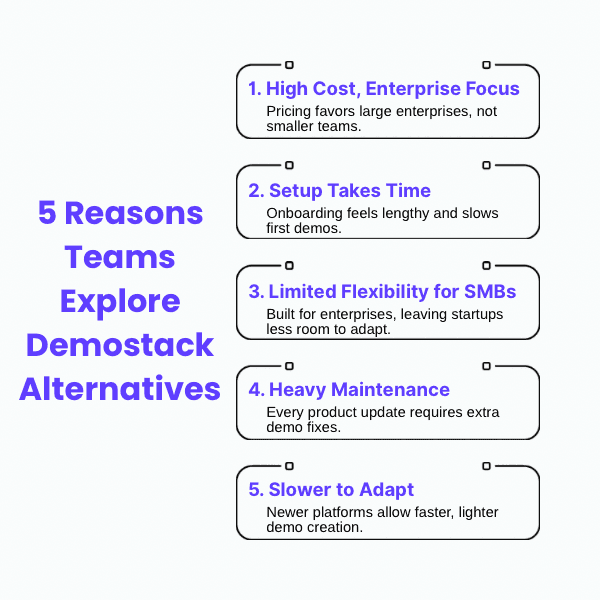
Demostack is a capable demo platform, but it’s not for everyone. Many teams find it too complex, too expensive, or just not built for how they work. If you’ve been hitting roadblocks with setup, budget, or flexibility, you’re not alone.
Below are five common reasons sales and marketing teams start searching for smarter, faster alternatives in 2025.
1. High Cost & Enterprise Focused
Let’s be honest, Demostack pricing is better suited for big enterprise budgets. If you’re a startup or mid-size team, the numbers can sting. Paying enterprise-level costs when you only need a handful of product demos just doesn’t add up.
2. Setup Feels Like a Project
Getting started with Demostack isn’t a quick plug-and-play. The setup process and onboarding stretch longer than most teams expect, and nobody wants their first demo delayed by weeks of prep.
3. Not Built for Small Teams
Startups and SMBs need tools that move as fast as they do. Demostack leans heavily toward enterprise workflows, leaving smaller teams wishing for more flexibility and a lighter touch.
4. Maintenance Never Ends
Every time your product updates, so does your demo environment. That means extra time spent tweaking demo content, managing updates, and keeping everything aligned, a constant chore for already busy sales teams.
5. Lacks the Agility Modern Teams Need
Today’s GTM teams want to spin up interactive demos in minutes, not wait on engineering or complex backend setups. Compared to newer, lightweight demo automation tools, Demostack can feel heavy and slow to adapt.
What Are the 5 Unique Demostack Alternatives You Need to Consider in 2025?
Demostack has its strengths, but there are faster, lighter, and more flexible alternatives. Here are five unique options for 2025, with what makes them tick, who they’re best for, and the pros and cons, plus one that’s built for speed, simplicity, and modern sales workflows.
1. SmartCue (G2 Rated 4.8/5)
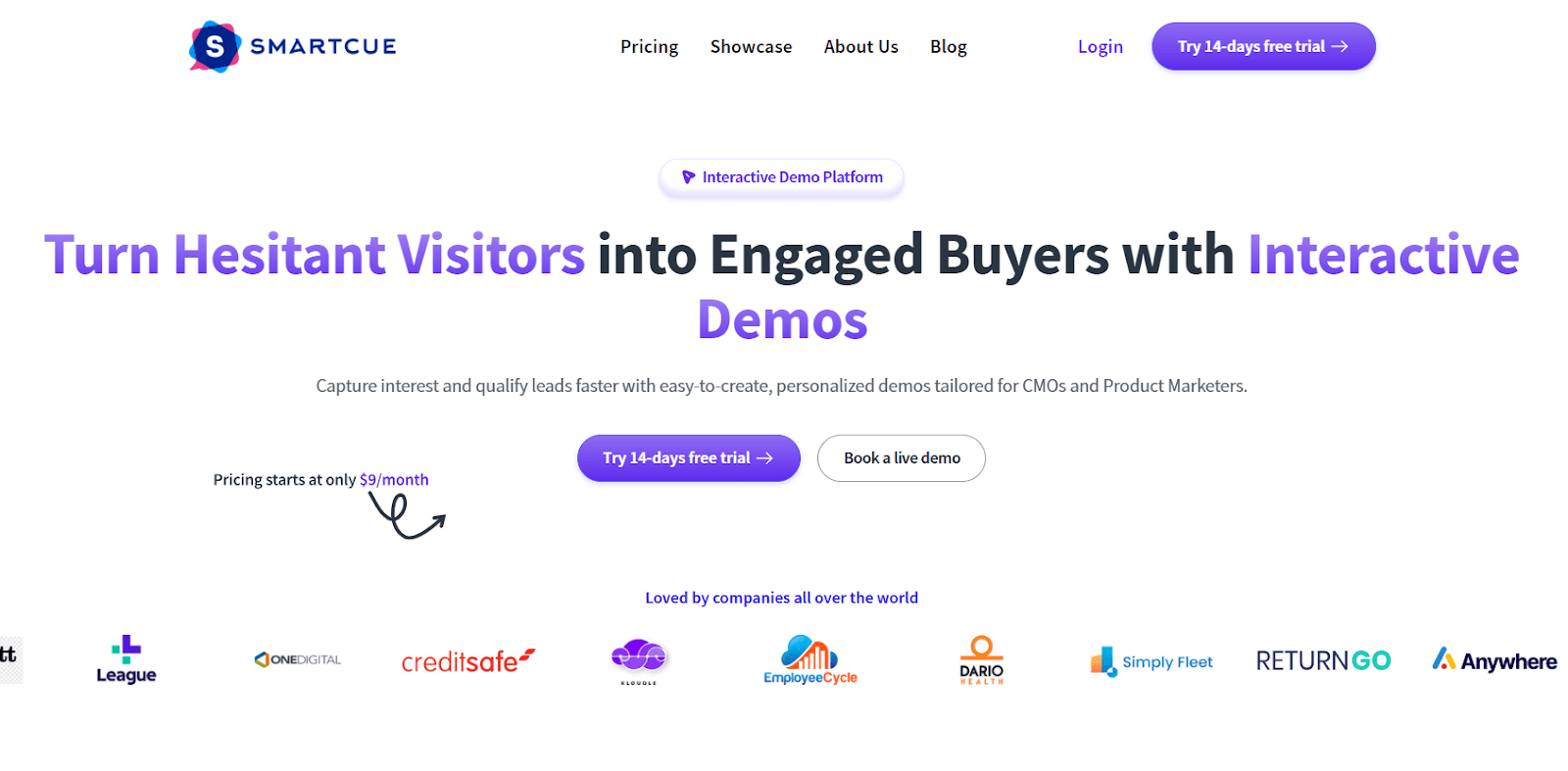
SmartCue is a fast, no-code demo platform for agile sales and marketing teams. It combines speed, flexibility, and personalized demos without technical headaches.
What Are SmartCue’s Standout Functions?
Quick, interactive no-code demo creation
Real-data personalization for prospects
Easy embedding across email, landing pages, and presentations
Intuitive, lightweight interface
Affordable for SMBs
Basic engagement tracking
Best for:
Startups, SMBs, and agile sales/marketing teams needing demos fast and cost-effectively.
What You’ll Pay?
Starts at just $10/month.
What Works Well in SmartCue?
Strips away unnecessary complexity; no overloaded workflows or hidden features.
Lets sales reps create polished demos in minutes without engineers or long training.
Enables easy sharing via links, website embeds, or email campaigns.
Provides built-in analytics to track where prospects engage most.
Keeps the focus on sales conversations rather than navigating software.
Where It Falls Short?
Not built for deep backend cloning
What Real Users Are Saying?
"Initially, I procured SmartCue to enhance our product demos, aiming to provide a more immersive and interactive experience for our prospects. What I didn't expect was the sheer adaptability of the tool! Beyond its core functionality… SmartCue has truly outperformed my expectations."
Tony G., Sr. Product Marketing Specialist, Enterprise
2. Walnut (G2 Rated 4.7/5)
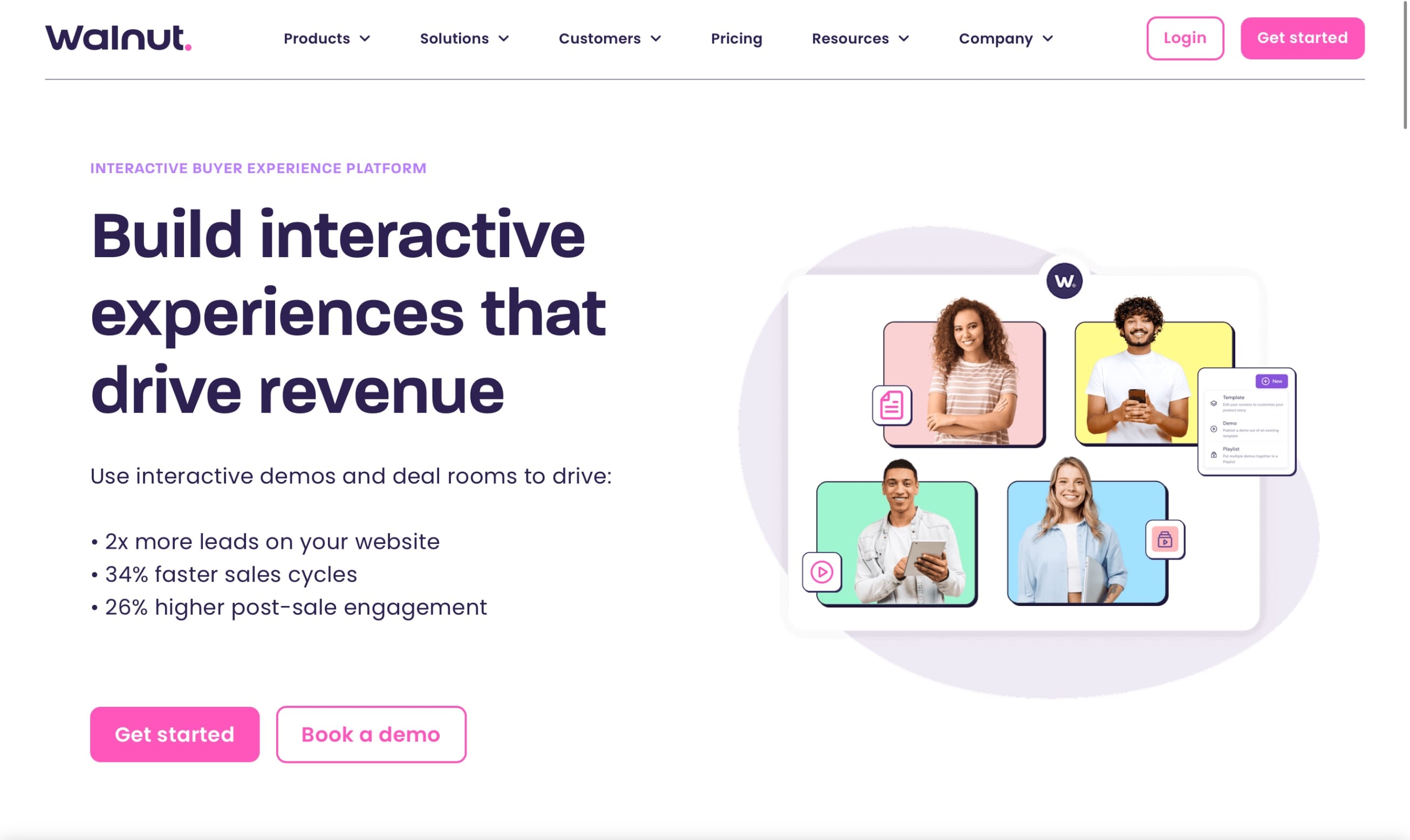
Walnut is enterprise-grade, designed for security, scalability, and complex sales cycles. Perfect for multi-stakeholder B2B workflows.
What Are Walnut‘s Standout Functions?
Enterprise-level security and compliance
Guided, interactive product tours
Advanced analytics for engagement
Customizable for different teams and segments
Supports large teams and complex workflows
Best for:
Enterprise sales teams managing long, multi-stakeholder buying cycles.
What You’ll Pay?
Paid plans start around $750/month, with higher tiers adding analytics, customization, and extra seats. Enterprise pricing available for large-scale rollouts.
What Works Well in Walnut?
Highly secure and scalable
Strong customization for enterprise needs
Fits complex sales processes
Where It Falls Short?
High cost
Slower setup
Heavy for small teams
What Real Users Are Saying?
“Using Walnut, it's so easy to create clickable demos to show during calls or to send to customers afterwards. Within a minute you can add a customer's logo to personalize the experience. Still some kinks in actually creating the demos, organizing them, and customizing - it took me a while to do the initial creation. Also it doesn't save automatically.”
3. Reprise (G2 Rated 4.6/5)
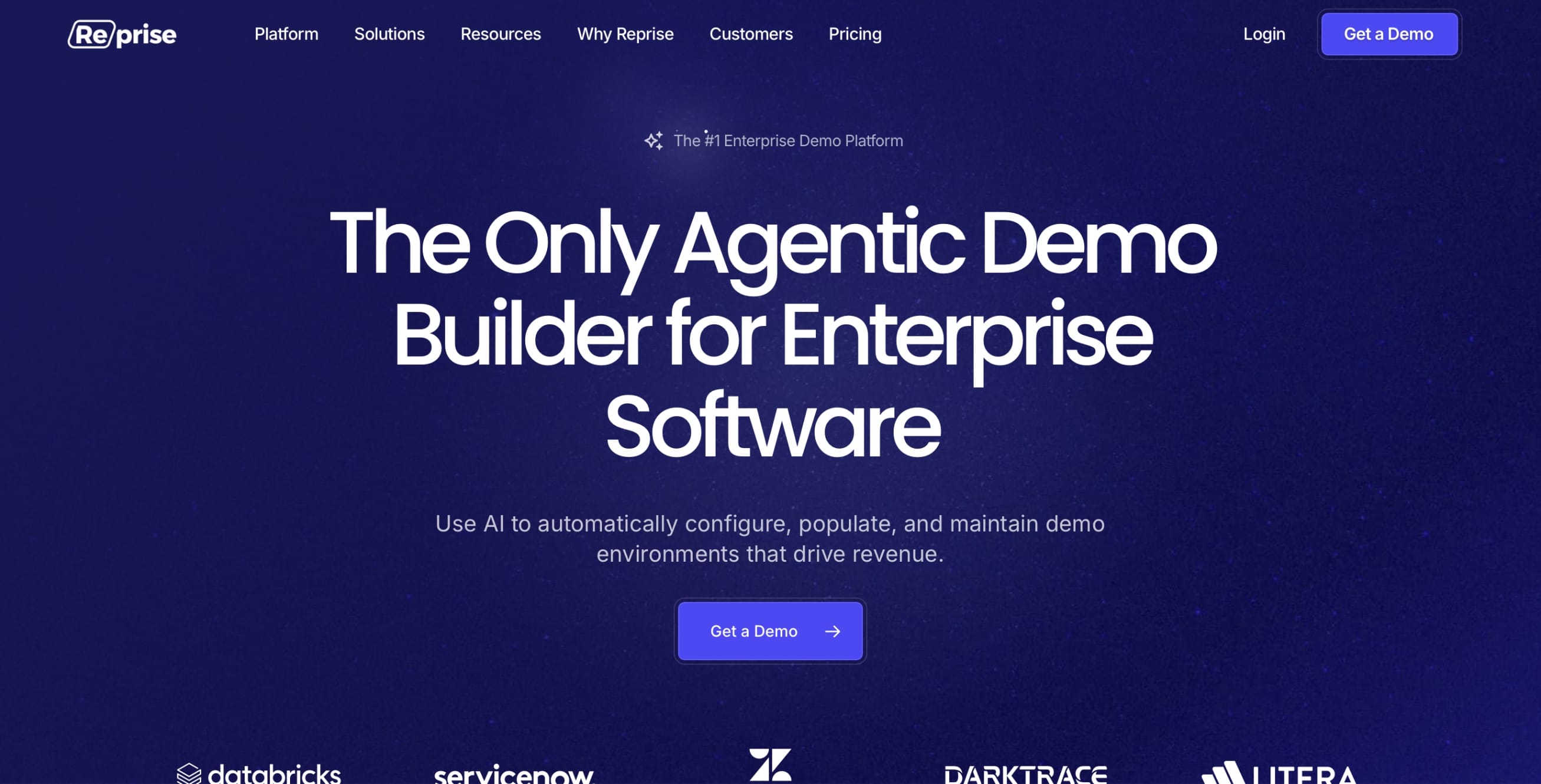
Reprise excels at technical depth, offering sandbox demos and API flexibility for teams needing full control of demos.
What Are Reprise‘s Standout Functions?
Sandbox demo environments
Backend and front-end cloning
API integrations
Advanced demo library for technical teams
Supports complex product workflows
Best for:
Large enterprises requiring deep customization and technical flexibility.
What You’ll Pay?
Custom pricing based on team size, usage, and security requirements.
What Works Well in Reprise?
Backend cloning capabilities
Sandbox environments for testing
API and technical integrations
Handles complex workflows
Where It Falls Short?
Long onboarding
Requires technical setup
Higher pricing
What Real Users Are Saying?
“Reprise allows us to scale our demos and verticalise in mostly easy UI friendly way without needing to create multiple environments.“
4. Consensus (G2 Rated 4.8/5)
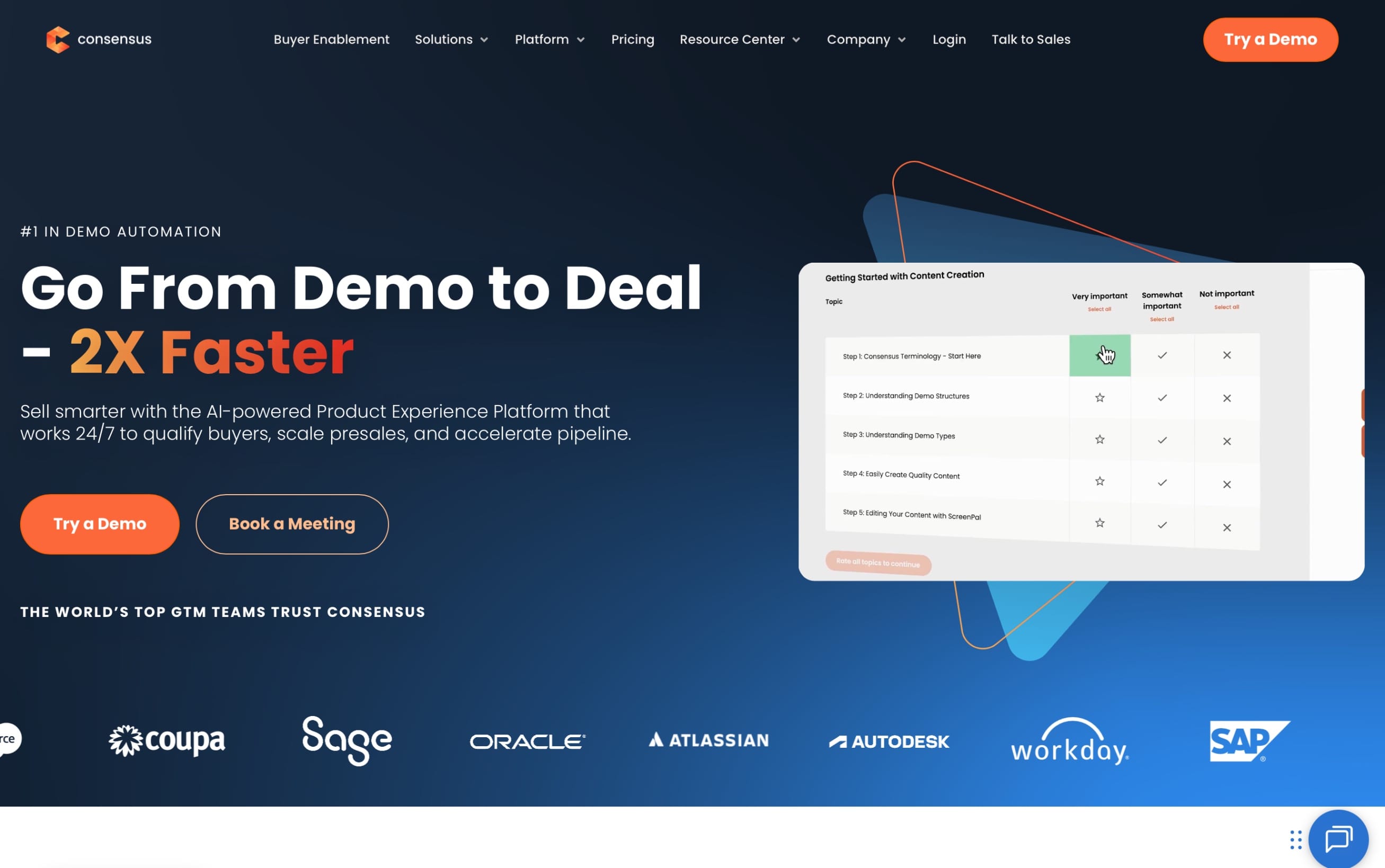
Consensus specializes in asynchronous, interactive, video-first demos for marketing campaigns and education-driven sales.
What Are Consensus‘s Standout Functions?
Asynchronous video demos
Automated demo personalization
Engagement tracking for viewers
Scales across multiple audiences
Best for:
Marketing teams aiming to educate prospects and scale outreach with video-led demos.
What You’ll Pay?
Custom pricing tailored to team size and demo volume.
What Works Well in Consensus?
Scalable video demos
Ideal for educational content
Trackable engagement
Where It Falls Short?
Limited live interactivity
Not ideal for complex technical demos
What Real Users Are Saying?
“The self-led customer demonstrations. As opposed to sending a Loom video, you can curate a specific video demonstration for your customer and track the engagement of your customers. When prospecting or working with a larger/more transactional book of business, this is a great tool for concise value adds in your outbound messaging and follow ups.“
- Tom L
5. Saleo (G2 Rated 4.9/5)
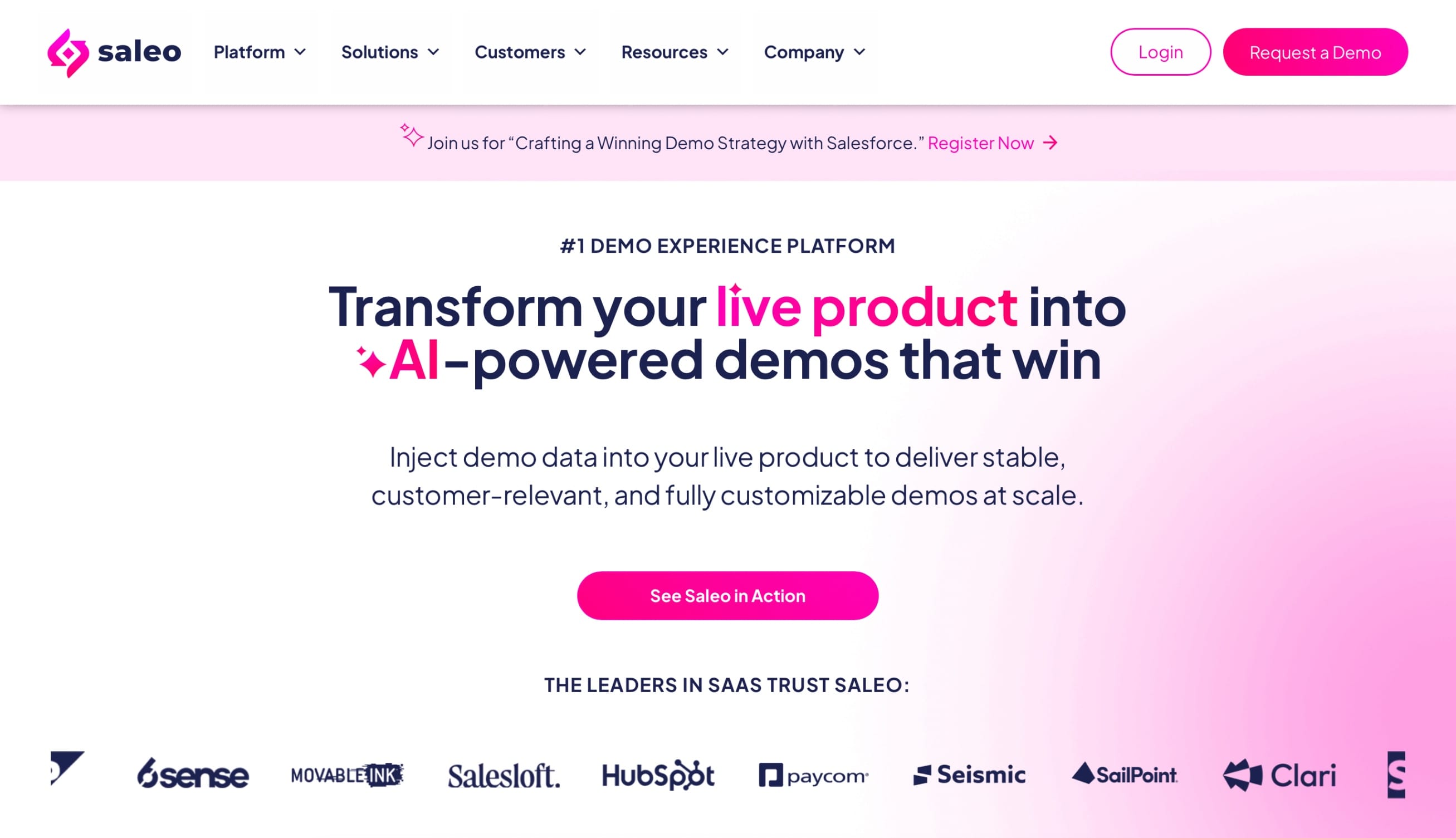
Saleo enables live product demos with real UI overlays and tailored data, creating authentic, persona-specific experiences.
What Are Saleo‘s Standout Functions?
Real product UIs with custom data
Live, interactive product tours
CRM and sales tool integrations
Tailored demos for prospects
Best for:
Sales teams wanting live, authentic product demos with personalized data.
What You’ll Pay?
Custom pricing tailored to team size and demo volume.
What Works Well in Saleo?
Authentic, live experience
Strong demo personalization
Real data integration
Where It Falls Short?
Requires maintenance
Learning curve for some teams
What Real Users Are Saying?
“It is great for days or people who don't have their demo sites up to par, like forgetting to run payroll, not having a lot of data to display especially if you are behind, that kind of aspect. It helps make their setups and build look pristine and more stream lined. It can be annoying to duplicate certain details or processes like your logo or name, but otherwise it is at least simple.”
Demostack Alternatives at a Glance
Finding the right demo platform can feel like a maze. To make it easier, here’s a quick comparison of the top Demostack competitors, with their best fits, features, pros, cons, and pricing.
Tool | Best For | Key Features | Pros | Cons | Pricing Insight |
|---|---|---|---|---|---|
SmartCue | Startups, SMBs, agile sales/marketing teams | No-code demo creation, real data personalization, embed across channels, lightweight, basic analytics | Fast setup, flexible, easy embedding, affordable | Limited backend cloning | Starts at $10/month |
Walnut | Enterprise sales teams with complex cycles | Enterprise security, guided tours, advanced analytics, segmentation, large team support | Highly secure, scalable, strong for enterprise sales | Expensive, slower implementation, heavy for small teams | Paid plans start ~$750/month; enterprise tiers available |
Reprise | Large enterprises that need technical flexibility | Sandbox environments, backend cloning, API integrations, advanced analytics | Sandbox demos, API flexibility, deep customization | Long onboarding, technical setup, pricey | Custom pricing based on team size and requirements |
Consensus | Marketing teams using video-led demos | Asynchronous video demos, automated personalization, viewer engagement tracking, scalable | Great for buyer education, scalable, built-in analytics | Less interactive live, limited technical demos | Custom pricing based on demo volume and team size |
Saleo | Sales teams showing live, real-product demos | Overlay real product UI, real-time interactive tours, CRM integrations | Authentic demos, strong customization, real data | Ongoing maintenance, steeper learning curve | Pricing varies by team size and plan |
How to Choose the Right Demostack Alternative for Your Business?
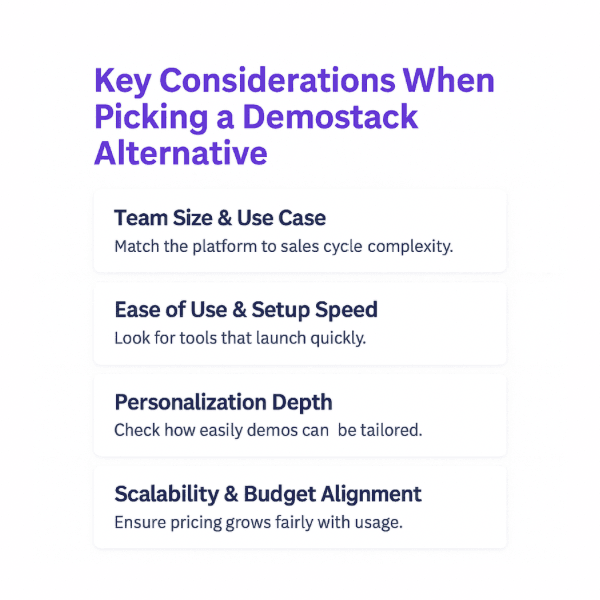
Choosing a demo platform isn’t just about features on a page; it’s about how well the tool fits your team’s daily reality. Here are four key questions to guide the decision.
1. How Big Is Your Team and What’s Your Use Case?
A startup with a lean sales team doesn’t need the same setup as an enterprise juggling dozens of stakeholders. Walnut and Reprise are built for complex, enterprise-grade cycles where customization and compliance matter most.
But if you’re a smaller team focused on quick, effective sales conversations, a lighter tool like SmartCue keeps you moving without the overhead.
2. How Quickly Can You Get Started?
Time to value is everything. Some platforms require long onboarding, training, and technical setup, and by the time you’re demo-ready, the sales window may have closed.
SmartCue eliminates setup headaches by letting you capture demos in your browser with a simple Chrome extension and add tooltips, blur fields, and highlight features without any code. This means your team can go from sign-up to a polished, shareable demo in minutes.
3. How Deep Do You Need Personalization to Go?
Every buyer wants to see themselves in your product. Saleo gives live overlays with custom data, and Consensus uses video demos tailored to each audience. Those can be powerful but also complex to maintain.
SmartCue makes personalization quick by letting you pan, zoom, blur, and add callouts in real time, so each demo feels tailored without extra rebuilds. You can also create reusable libraries and guided flows for different user segments, making it easy to adapt one demo for multiple audiences in minutes.
4. Does the Tool Match Your Budget and Growth Plans?
Pricing isn’t just about what you pay today, but how costs scale tomorrow. Enterprise platforms often come with big contracts and annual commitments.
SmartCue’s pricing scales with your needs, starting at $10 per user/month for Essential and $30 per user/month for Growth, with a Custom Enterprise plan for larger teams. This tiered setup lets small teams start lean and upgrade only when demo volume or compliance needs increase, avoiding heavy upfront costs.
Ready to see how effortless demos can be? Start your 14-day free trial of SmartCue today and experience the difference of a platform built for simplicity, speed, and results.
How to Create an Interactive Demo with SmartCue in 4 Simple Steps
Turning buyer interest into real conversations doesn’t have to be complicated. With SmartCue, you can launch a polished demo in minutes by following these quick steps:
Step 1: Sign Up and Get Started
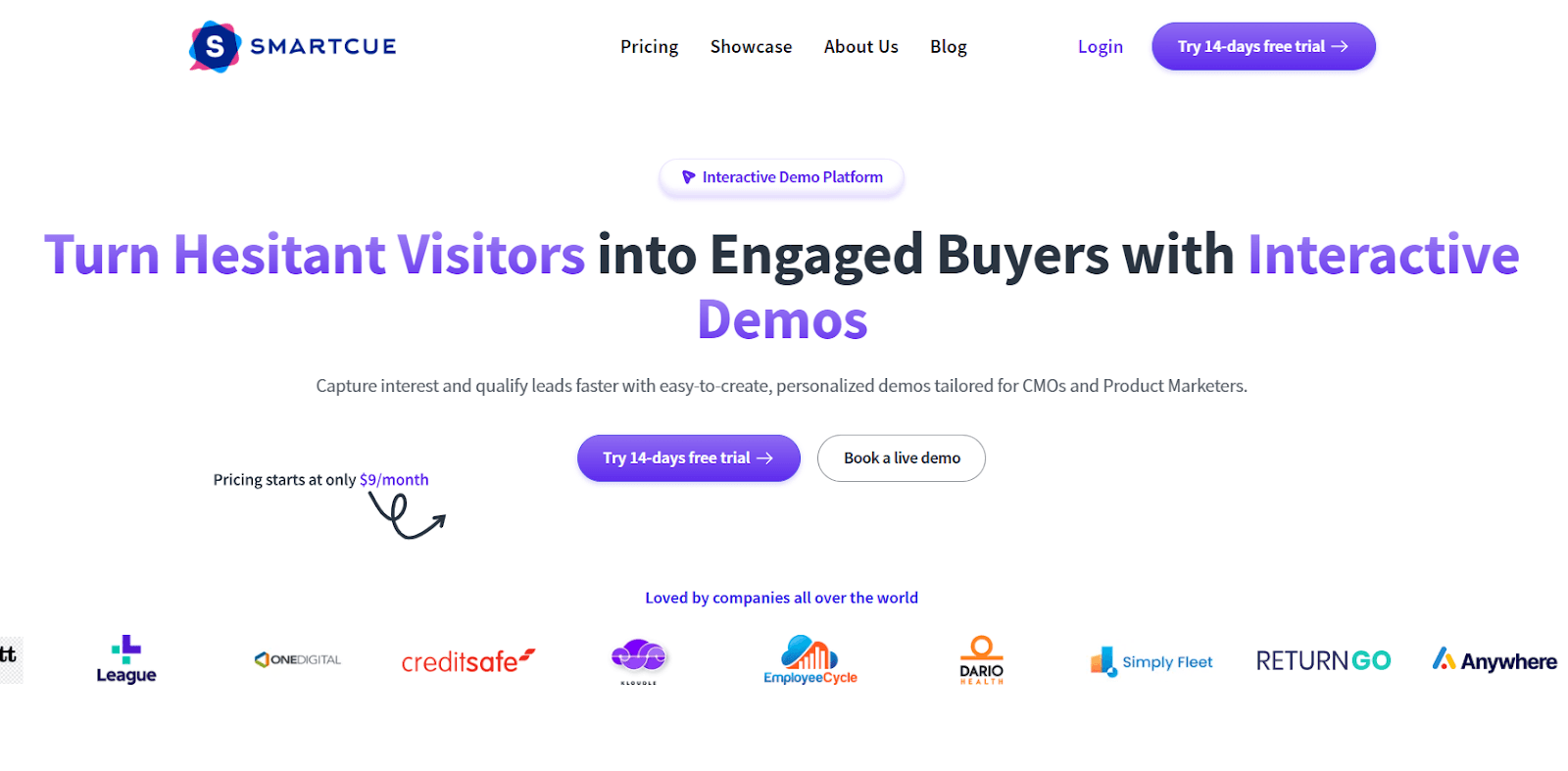
Begin with a free trial and explore SmartCue’s clean, intuitive dashboard; no steep learning curve required.
Step 2: Capture Your Flow
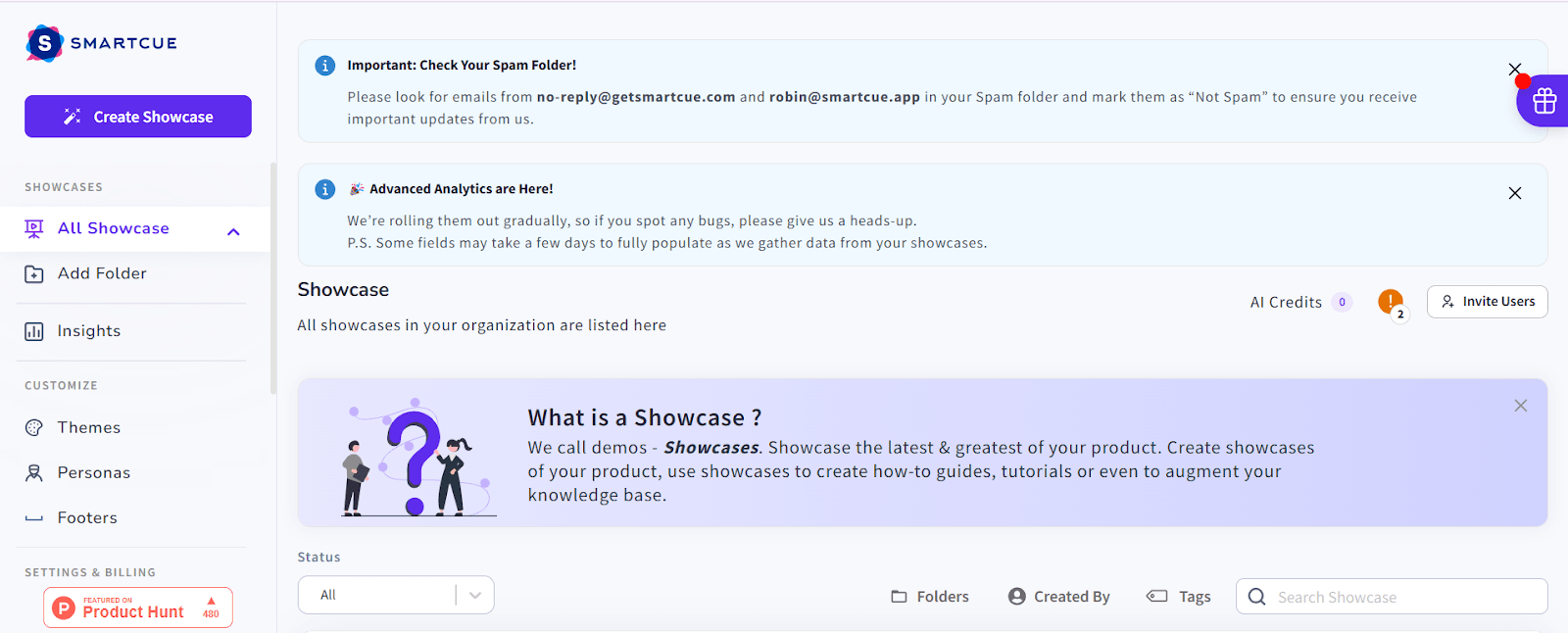
Create a new showcase by uploading your content or using the SmartCue browser extension to capture product screens in seconds.
Step 3: Customize and Personalize
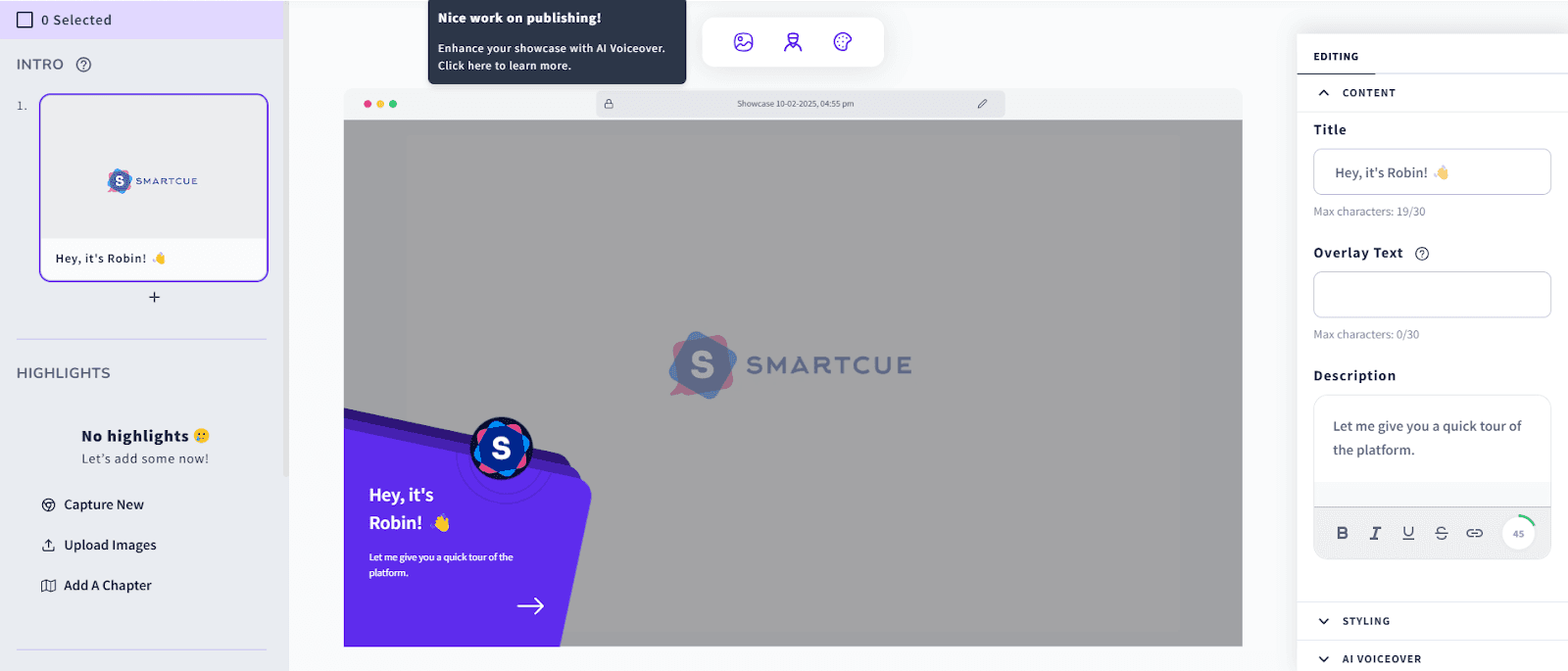
Add text, highlight key features, and tailor your demo so it feels relevant to each prospect.
Step 4: Publish and Share Anywhere
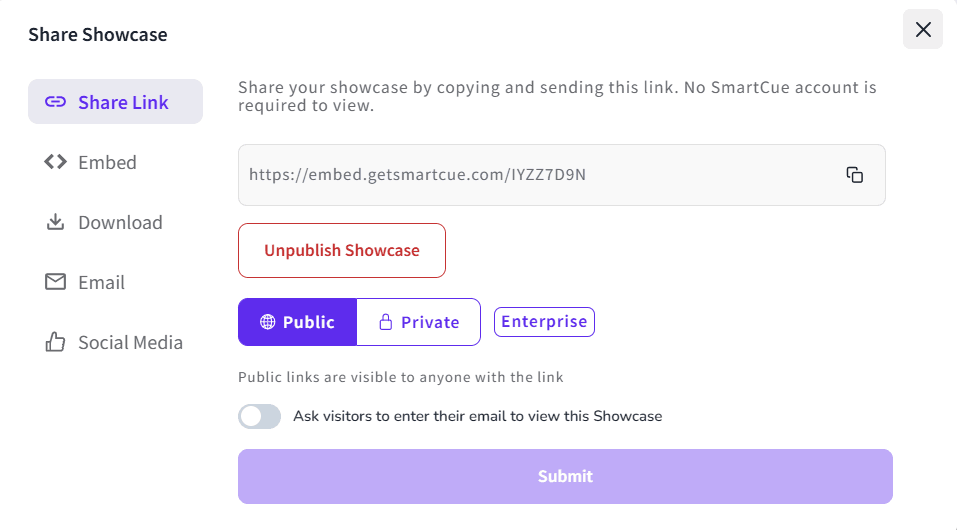
Save your demo, then share it instantly through a link, embed it in emails, or drop it into sales decks—meeting buyers where they are.
Prefer a walkthrough? Book a live demo and let us show you how easy it is.
Making the Smart Choice for Your Team
Choosing a demo platform isn’t just about features; it’s about fit. Your team moves fast, needs personalization, and has limited time and budget. The right tool should simplify your workflow, not slow it down.
Demostack alternatives offer a range of strengths, from deep technical control to quick, no-code setup. The best pick depends on your team size, sales motion, and growth stage.
Key takeaways for you:
Prioritise tools that match your team’s speed and workflow.
Look for easy setup, flexible personalization, and clear ROI.
The right platform should help you spark interest, build trust, and close faster, not add complexity.
Frequently Asked Questions
Are there any limitations or drawbacks of using Demostack for interactive demos?
Demostack creates polished interactive product demos, but many teams find the demo creation process complex. It requires upkeep whenever front end changes happen, and scaling across team members can be tricky. Costs also rise with the number of users and advanced customization options.
Can you provide real user reviews and testimonials about their experience with Demostack?
Demostack reviews often highlight strong demo assets and unique features like demo centers, but also note challenges with ease of use and customer support. Some teams mention better customer success experiences with a dedicated customer success manager compared to others in this demo automation platform space.
Do personalized interactive demos actually work?
Yes, when used well, personalized interactive demo software improves user experience and boosts sales enablement. Features such as lead capture, detailed analytics, and integration with tools like Google Analytics help teams track engagement and align demos with specific needs for customer success.
How does Demostack work?
Demostack is demo software that lets companies build interactive product tours and live demo environments without relying on production systems. Using a Chrome extension, teams capture flows, edit them with customization options, and share demos easily. Annual plans vary based on pricing plans.
Why pick SmartCue over Demostack?
SmartCue is often considered one of the best Demostack alternatives because of its focus on ease of use and specific pricing. It allows quick demo call setup, smooth support team access, and flexible demo automation platform features that scale with different products.
How does Demostack compare vs Walnut?
In Walnut vs Demostack comparisons, Walnut offers strong enterprise-grade live demo environments, while Demostack focuses on interactive product demos. Walnut suits bigger demo centers with advanced customer success resources, whereas Demostack appeals to those needing flexibility, albeit with similar features across both demo automation platform options.
How does Demostack compare vs Reprise?
In Demostack vs Reprise matchups, Reprise provides deeper front-end cloning, replay options like Reprise replay, and extensive demo assets. Demostack emphasizes interactive demo software and customization options. Both can support team members across enterprises, though Reprise may fit complex use cases better.


